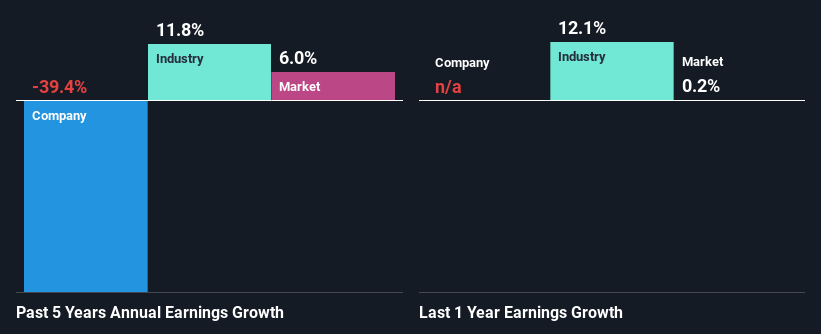- Hong Kong
- /
- Hospitality
- /
- SEHK:1181
Is Tang Palace (China) Holdings Limited's (HKG:1181) Stock Price Struggling As A Result Of Its Mixed Financials?

It is hard to get excited after looking at Tang Palace (China) Holdings' (HKG:1181) recent performance, when its stock has declined 16% over the past three months. It is possible that the markets have ignored the company's differing financials and decided to lean-in to the negative sentiment. Stock prices are usually driven by a company’s financial performance over the long term, and therefore we decided to pay more attention to the company's financial performance. Specifically, we decided to study Tang Palace (China) Holdings' ROE in this article.
Return on Equity or ROE is a test of how effectively a company is growing its value and managing investors’ money. Simply put, it is used to assess the profitability of a company in relation to its equity capital.
See our latest analysis for Tang Palace (China) Holdings
How To Calculate Return On Equity?
Return on equity can be calculated by using the formula:
Return on Equity = Net Profit (from continuing operations) ÷ Shareholders' Equity
So, based on the above formula, the ROE for Tang Palace (China) Holdings is:
1.6% = CN¥4.0m ÷ CN¥245m (Based on the trailing twelve months to June 2024).
The 'return' is the income the business earned over the last year. Another way to think of that is that for every HK$1 worth of equity, the company was able to earn HK$0.02 in profit.
Why Is ROE Important For Earnings Growth?
We have already established that ROE serves as an efficient profit-generating gauge for a company's future earnings. Depending on how much of these profits the company reinvests or "retains", and how effectively it does so, we are then able to assess a company’s earnings growth potential. Assuming all else is equal, companies that have both a higher return on equity and higher profit retention are usually the ones that have a higher growth rate when compared to companies that don't have the same features.
Tang Palace (China) Holdings' Earnings Growth And 1.6% ROE
It is hard to argue that Tang Palace (China) Holdings' ROE is much good in and of itself. Even when compared to the industry average of 6.8%, the ROE figure is pretty disappointing. Therefore, it might not be wrong to say that the five year net income decline of 39% seen by Tang Palace (China) Holdings was possibly a result of it having a lower ROE. We believe that there also might be other aspects that are negatively influencing the company's earnings prospects. Such as - low earnings retention or poor allocation of capital.
So, as a next step, we compared Tang Palace (China) Holdings' performance against the industry and were disappointed to discover that while the company has been shrinking its earnings, the industry has been growing its earnings at a rate of 12% over the last few years.

Earnings growth is an important metric to consider when valuing a stock. What investors need to determine next is if the expected earnings growth, or the lack of it, is already built into the share price. Doing so will help them establish if the stock's future looks promising or ominous. If you're wondering about Tang Palace (China) Holdings''s valuation, check out this gauge of its price-to-earnings ratio, as compared to its industry.
Is Tang Palace (China) Holdings Using Its Retained Earnings Effectively?
In spite of a normal three-year median payout ratio of 26% (that is, a retention ratio of 74%), the fact that Tang Palace (China) Holdings' earnings have shrunk is quite puzzling. So there might be other factors at play here which could potentially be hampering growth. For example, the business has faced some headwinds.
In addition, Tang Palace (China) Holdings has been paying dividends over a period of at least ten years suggesting that keeping up dividend payments is way more important to the management even if it comes at the cost of business growth.
Summary
Overall, we have mixed feelings about Tang Palace (China) Holdings. While the company does have a high rate of reinvestment, the low ROE means that all that reinvestment is not reaping any benefit to its investors, and moreover, its having a negative impact on the earnings growth. Wrapping up, we would proceed with caution with this company and one way of doing that would be to look at the risk profile of the business. You can see the 4 risks we have identified for Tang Palace (China) Holdings by visiting our risks dashboard for free on our platform here.
Valuation is complex, but we're here to simplify it.
Discover if Tang Palace (China) Holdings might be undervalued or overvalued with our detailed analysis, featuring fair value estimates, potential risks, dividends, insider trades, and its financial condition.
Access Free AnalysisHave feedback on this article? Concerned about the content? Get in touch with us directly. Alternatively, email editorial-team (at) simplywallst.com.
This article by Simply Wall St is general in nature. We provide commentary based on historical data and analyst forecasts only using an unbiased methodology and our articles are not intended to be financial advice. It does not constitute a recommendation to buy or sell any stock, and does not take account of your objectives, or your financial situation. We aim to bring you long-term focused analysis driven by fundamental data. Note that our analysis may not factor in the latest price-sensitive company announcements or qualitative material. Simply Wall St has no position in any stocks mentioned.
About SEHK:1181
Tang Palace (China) Holdings
An investment holding company, engages in the restaurant operation and food production businesses in the People’s Republic of China.
Flawless balance sheet slight.


